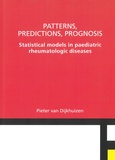Patterns, predictions, prognosis
Statistical models in paediatric rheumatologic diseases

Dijkhuizen, Pieter van
- Promoter:
- Nico Wulffraat & Alberto Martini
- Co-promoter:
- C. Malattia
- Date:
- February 27, 2018
- Time:
- 12:00 h
Summary
It is currently impossible to predict the prognosis of children with juvenile idiopathic arthritis (JIA) leading to difficulties in the determination of the right treatment for each patient. Currently known predictors are insufficient to make accurate predictions. In a large, prospective study of Italian and Dutch JIA patients at disease onset, we try to find new predictors of future disease activity, among clinical variables, joint ultrasound, inflammatory compounds in blood plasma and the gut microbiota composition. No accurate model of disease activity can be made when grouping all patients together. However, interesting candidate predictors, such as the inflammatory compound CXCL-9 or the gut microbiota operational taxonomic unit (OTU) Mogibacteriaceae are discovered when all patients are split into more homogeneous subgroups. When comparing this cohort of patients with healthy children, it is furthermore discovered that the composition of gut microbiota differs between Italian JIA patients and Italian healthy children. The most remarkable differences are an increased abundance of Erysipelotrichaceae and a decreased abundance of Allobaculum in patients. Similar, but more subtle, differences are found between Dutch JIA patients and healthy children. These findings lead to the hypothesis of involvement of the gut microbiota in the pathogenesis of JIA and might in future be used to find new treatments for JIA. Similarly, the prognosis of children suffering from another rheumatologic disease, juvenile dermatomyositis (JDM), cannot be predicted. We develop a joint model of four disease activity parameters using a large inception cohort of JDM patients enrolled in the United Kingdom. This model is developed using Bayesian statistics, including subject-specific intercepts and accounting for correlations among the four disease activity parameters. Using this model, we find clinical signs and symptoms that are associated with increased disease activity, such as dysphonia, myalgia, nail fold changes and joint swelling. These variables can be used in future to stratify patients into subgroups with similar prognosis, needing more aggressive treatment. Moreover, the model provides information about correlations among the disease activity parameters, information that can be used to determine a parsimonious set of outcome parameters to be used in daily clinical practice. Methotrexate (MTX) is the corner-stone treatment of JIA and is also frequently used in the treatment of JDM. It is a relatively safe drug, however we find that up to 50% of patients on MTX suffer from MTX intolerance. This is a combination of gastro-intestinal disturbances, such as nausea, vomiting or abdominal ache, occurring not only after the administration of MTX, but also before administration, or when being reminded of the drug, often associated with behavioural disturbances, such as irritability or refusal to take the drug. There is currently no effective treatment of MTX intolerance. In a cohort of new MTX users, we discover that it is impossible to predict who is going to develop intolerance. Therefore, the occurrence of MTX intolerance should be monitored frequently, and adequate action should be taken, such as a switch to other drugs, once it ensues.